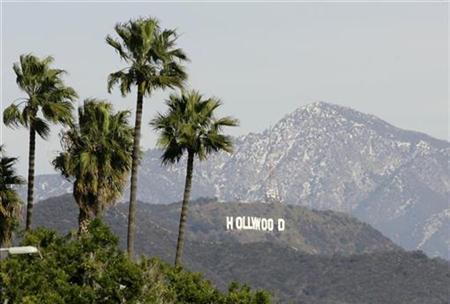Snow Study Shows California Faces Historic Drought
Country: US
Author: Clare Baldwin

The Hollywood Sign is seen between palm trees and snow dusted mountains in
Los Angeles January 7, 2008.
Photo: Danny Moloshok
SAN FRANCISCO - A new survey of California winter snows on Thursday showed the most populous state is facing one of the worst droughts in its history, Gov. Arnold Schwarzenegger said.
The state, which produces about half the United States' vegetables and fruit, is in its third year of drought and its main system supplying water to cities and farms may only be able to fulfill 15 percent of requests, scientists said.
The snowpack on California's mountains is carrying only 61 percent of the water of normal years, according to the survey by the state Department of Water Resources. Last year the snowpack held 111 percent of the normal amount of water, but spring was the driest ever recorded.
"California is headed toward one of the worst water crises in its history, underscoring the need to upgrade our water infrastructure by increasing water storage, improving conveyance, protecting the (Sacramento) Delta's ecosystem and promoting greater water conservation," Schwarzenegger said in a statement.
"We may be at the start of the worst California drought in modern history," added Water Resources Director Lester Snow in a separate statement.
Schwarzenegger has pushed for new dams and reservoirs to catch melting snow which feeds rivers, although environmentalists have opposed the measures. The Sierra snowpack alone provides two thirds of California's water supply.
December through January tend to be the wettest months but thus far the Sierra has only received one third of its expected annual snowfall.
"A third of normal is devastating," said Elissa Lynn, a meteorologist with the state. "January is the biggest month for precipitation in the Sierra."
"Climate change does indicate the possibility of more frequent droughts," said Lynn, "but it's hard to tell over a short time span."
This year ocean temperatures in the equatorial Pacific are cooler than normal in a weather system called La Nina. In northern California, that means less precipitation. Last year was also a La Nina year, but precipitation didn't slow until March and April.
"This could be a crisis situation," said Lynn. "In addition to conservation and rationing we could be paying higher prices for produce." Lynn said that some farmers have left fields unplanted based on expected lack of water.
Twenty-five local water agencies are already mandating rationing. The state Department of Water Resources is arranging water transfers through its Drought Water Bank program and expects to release a full snowpack runoff forecast in two weeks.
(Editing by Peter Henderson and Eric Walsh)
© Thomson Reuters 2009 All rights reserved
